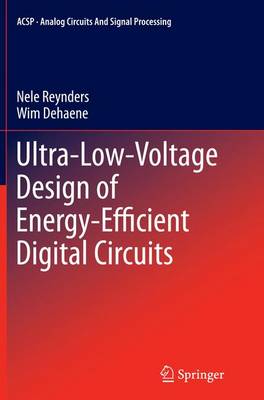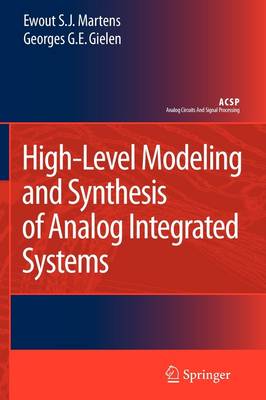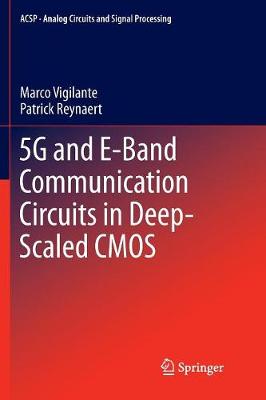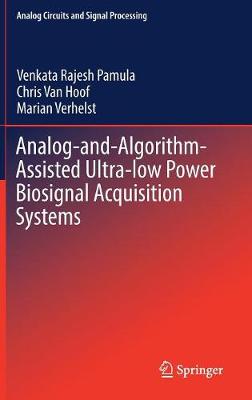Analog Circuits and Signal Processing
1 primary work • 11 total works
Book 128
Temperature- and Supply Voltage-Independent Time References for Wireless Sensor Networks
by Valentijn De Smedt, Georges Gielen, and Wim Dehaene
This book investigates the possible circuit solutions to overcome the temperature and supply voltage-sensitivity of fully-integrated time references for ultra-low-power communication in wireless sensor networks. The authors provide an elaborate theoretical introduction and literature study to enable full understanding of the design challenges and shortcomings of current oscillator implementations. Furthermore, a closer look to the short-term as well as the long-term frequency stability of integrated oscillators is taken. Next, a design strategy is developed and applied to 5 different oscillator topologies and 1 sensor interface. All 6 implementations are subject to an elaborate study of frequency stability, phase noise and power consumption. In the final chapter all blocks are compared to the state of the art.
Ultra-Low-Voltage Design of Energy-Efficient Digital Circuits
by Nele Reynders and Wim Dehaene
Smart energy management, both at design time and at run time, is indispensable in modern radios. It requires a careful trade-off between the system’s performance, and its power consumption. Moreover, the design has to be dynamically reconfigurable to optimally balance these parameters at run time, depending on the current operating conditions.
Energy Scalable Radio Design describes and applies an energy-driven design strategy to the design of an energy-efficient, highly scalable, pulsed UWB receiver, suitable for low data rate communication and sub-cm ranging. This book meticulously covers the different design steps and the adopted optimizations: System level air interface selection, architectural/algorithmic design space exploration, algorithmic refinement (acquisition, synchronization and ranging algorithms) and circuit level (RTL) implementation based on the FLEXmodule-concept. Measurement results demonstrate the effectiveness and necessity of the energy-driven design strategy.
High-Level Modeling and Synthesis of Analog Integrated Systems
by Ewout S. J. Martens and Georges Gielen
Various approaches for finding optimal values for the parameters of analog cells have made their entrance in commercial applications. However, a larger impact on the performance is expected if tools are developed which operate on a higher abstraction level and consider multiple architectural choices to realize a particular functionality. This book examines the opportunities, conditions, problems, solutions and systematic methodologies for this new generation of analog CAD tools.
Continuous-Time Digital Front-Ends for Multistandard Wireless Transmission
by Pieter a J Nuyts, Patrick Reynaert, and Wim Dehaene
RF Power Amplifiers for Mobile Communications
by Patrick Reynaert and Michiel Steyaert
This book tackles both high efficiency and high linearity power amplifier (PA) design in low-voltage CMOS. With its emphasis on theory, design and implementation, the book offers a guide for those actively involved in the design of fully integrated CMOS wireless transceivers. Offering mathematical background, as well as intuitive insight, the book is essential reading for RF design engineers and researchers and is also suitable as a text book.
Variation-Aware Analog Structural Synthesis
by Trent McConaghy, Pieter Palmers, Peng Gao, Michiel Steyaert, and Georges Gielen
SRAM Design for Wireless Sensor Networks
by Vibhu Sharma, Francky Catthoor, and Wim Dehaene
This book features various, ultra low energy, variability resilient SRAM circuit design techniques for wireless sensor network applications. Conventional SRAM design targets area efficiency and high performance at the increased cost of energy consumption, making it unsuitable for computation-intensive sensor node applications. This book, therefore, guides the reader through different techniques at the circuit level for reducing energy consumption and increasing the variability resilience. It includes a detailed review of the most efficient circuit design techniques and trade-offs, introduces new memory architecture techniques, sense amplifier circuits and voltage optimization methods for reducing the impact of variability for the advanced technology nodes.
5G and E-Band Communication Circuits in Deep-Scaled CMOS
by Marco Vigilante and Patrick Reynaert
Analog-and-Algorithm-Assisted Ultra-low Power Biosignal Acquisition Systems
by Venkata Rajesh Pamula, Chris Van Hoof, and Marian Verhelst
- First book to present the so called, "analog-and-algorithm-assisted" approaches for ultra-low power biosignal acquisition and processing platforms;
- Covers the recent trend of "beyond Nyquist rate" signal acquisition and processing in detail, including adaptive sampling and compressive sampling paradigms;
- Includes chapters on compressed domain feature extraction, as well as acquisition of photoplethysmogram, an emerging optical sensing modality, including compressive sampling based PPG readout with embedded feature extraction;
- Discusses emerging trends in sensor fusion for improving the signal integrity, as well as lowering the power consumption of biosignal acquisition systems.
Mm-wave Circuit Design in 16nm FinFET for 6G Applications
by Bart Philippe and Patrick Reynaert
This book tackles the challenges of designing mm-wave circuits in 16nm FinFET, from the elementary transistor level to a measured D-band transmitter. The design of crucial building blocks such as oscillators and power amplifiers are covered through theoretical limitations, design methodology and measurement.
- Offers first book on design of mm-wave circuits above 100GHz in an advanced 16nm FinFET digital technology;
- Covers fundamentals of transistor layout, circuit implementation and measurements;
- Provides single-source reference to information otherwise only available in disparate literature.









